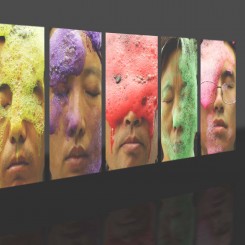“Until The End Of The World“ (group exhibition of contemporary video art)
Tang Contemporary (Gate No.2, 798 factory, Jiuxianqiao Road, Chaoyang Dst. Beijing, China) Sept 29 – Nov 20, 2012
The nine video works in “Until the End of the World” made for a welcome occupation of Tang’s expansive 798 gallery. Dissolved in darkness, the space lost its architecture, giving way to the interior structures of various video works mounted carefully inside it. The exhibition’s title enlists a reference to Wim Wender’s 1991 film “Until the End of the World” which posits that, after all else is gone, a web of images will remain as the residues of our psychologically reconstructed reality. But until then, the kinds of images presented in these videos form the most part of our visual experience — sights drawn from daily life — or its sensations, as recorded or reflected in the work of different artists.
Commanding the space were five large panels hanging overhead — “Popular Standard Colour Shampoo” (2012) by Wang Gongxin. Each panel displays an unwavering close-up of a face daubed with brightly coloured foam. It is at once a comical and somewhat pathetic frieze, with eyes closed as if in awkward repose, drips of lurid pigment running into the clefts of lips and bubbles congregating irritatingly round nostrils. There is something voyeuristic in watching the scene gently unfolding slowly before our eyes and which obscures theirs; the foam lends itself both to comic timing and to visible metaphors of awkwardness or social inhibition.
Diagonally across from this is a screen featuring Zhang Peili’s highly realistic 30-channel video “480 Minutes” (2008). In it, cameras are trained on seamstresses at work in a clothes factory. The most “literal” work in the exhibition, it provides a raw counterpoint to the more forcibly artistic works present. A real sewing machine of the type used by these women stands before the screen in a skillful transposition of tangible reality alongside its recorded image. Questions of artistic responsibility hover around this work, which amounts to a pure act of surveillance. One is led towards questions about what purpose such an activity and its representation might really serve, its relevance both to the audience, and to those captured (unawares) on film. A video “Imagery Knowledge Science” (2011) by younger artist Lin Yilin on the facing wall aspires to offer a positive counterpoint for a social-political/artistic activity. A group of people are guided down a back alley in Vancouver’s Chinatown and participants asked to recite the physical descriptions of wanted criminals from wall posters. In relation to the direct visual impact of many of the other works, however, this long loop fails to corner the attention, and one might lose patience, without the help of an explanation, for establishing its premise.
A second work by Wang Gongxin and an adjacent one by Liu Chang are the most visually sensuous pieces in the exhibition. Wang’s “Still Life” (Nos. 1-4) feature plastic bags, branches and a golden skull across four panels in which barely detectable movements part these compositions from the realm of representational art, edging them subtly into the frame of time and its progress. The “life” contained in these works remains, however, different from that which unfolds around us in real time — their inner life is one neither of direct reality, nor of the static image as invested by the painter, but something in between. “#14” (2012) by Liu Chang places two white architectural boxes facing each other; a neon-blue projected light migrates across them, expanding and contracting in a manner that aptly “performs” the essence of film on screen. This disarmingly simple piece invites itself into the memory with a combination of lyrical movement and an uncanny staging that aptly distil the pure form and visual experience of film.
In a separate room one encounters a second work by Zhang Peili. “Q&A and Q&A” (2011) is a skilful intervention in the experience of a hearing, seeing and reading an interrogation. Small screens mounted on metal arms from the wall face each other in three pairs — in one, the video of a criminal and policeman talking; the other two hold the English and Chinese transcriptions of the conversation. It is an inventive and thought-provoking presentation wherein the relationship between sound, image, word and expression are rendered unstable and disparate, as one must approach each pair of screens, drawn close together, to see or hear each part. An impression of Zhang’s versatility is perfectly delivered through the juxtaposition of this careful experimental work and “Constantly Expanding” (2000), a legion of twelve screens each showing a mouth chewing and blowing bubble gum, a scene brashly evocative of pop culture, and not without humour. The final work in the exhibition is a rather romantic, filmic piece by Chen Zhou. “My loving artist—Yu Honglei” (2012) is less a video than a short film, the lens trained on a young man seated before a mirror looking through photographs from his life. The work is beautifully composed, with a distinct sense of its own atmosphere.
“Until the End of the World” thus presented a highly engaging slew of video for the contemporary moment. The exhibition justified the time taken to contemplate every work and to engage with the particular character of each. A particular strength was to have demonstrated both the breadth of visual language employed by this group of artists, and also, in some cases, to have demonstrated the different approaches included in the oeuvres of individuals. The gallery succeeded in mounting an almost museum-worthy show in a medium that all too often falls foul of viewers’ patience, technical efficiency and the quality of presentation. A solid and memorable affirmation of filmic possibilities in contemporary Chinese art.
